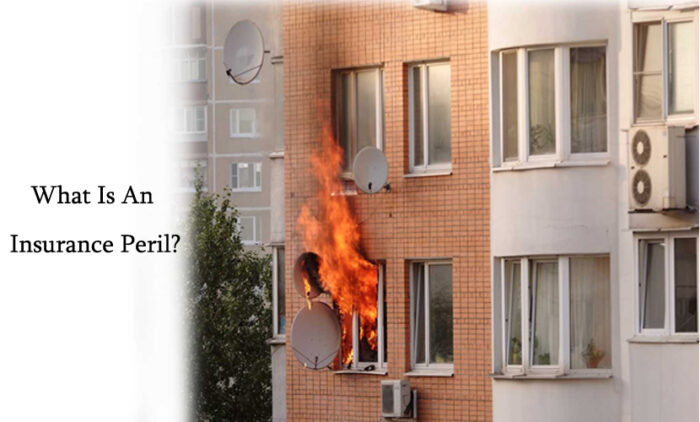An insurance peril is often defined as a situation or incident that causes harm to property. Examples of perils include windstorms, fires, power surges, and falling objects.

Insurance providers specify the perils they protect against and those they do not. Typical covered perils include lightning strikes, hail damage, and vandalism.
However, understanding perils is important as they represent potential risks to your property. Identifying the perils covered by your insurance policy can help you prepare for unforeseen events and ensure adequate protection for your assets.
By acquainting yourself with the perils included in your coverage, you can make informed decisions about safeguarding your property and effectively mitigating risks.
Categories Of Insurance Peril
In simple terms, home insurance provides financial security against unexpected occurrences. Within the insurance domain, these unforeseen and detrimental incidents are referred to as perils.
Should a peril transpire and result in property damage, you have the option to submit a claim to your home insurance company for assistance in covering the necessary repairs.
In the meantime, a standard homeowner’s insurance policy outlines a set of sixteen (16) specific events known as named policy perils. They include:
- Fire or lightning.
- Vandalism or malicious acts.
- Theft.
- Civil commotion.
- Smoke and ash.
- Volcanic eruptions.
- Falling objects.
- Power surges.
- Damage from vehicles.
- Damage from aircraft.
- Weight of snow, ice, or sleet.
- Hail or windstorms.
- Explosions.
- Rupture or cracking of hot water, air conditioning, or fire sprinkler systems.
- Freezing of heating, plumbing, fire sprinkler, or air conditioning systems, or household appliances.
Lastly, accidental water overflow, discharge from heating, plumbing, fire sprinkler, air conditioning systems, or household appliances.
Which Perils Are Commonly Excluded From Coverage?
Although you may have extensive peril coverage in your homeowners’ policy, there are still some situations and incidents that remain uncovered.
To secure coverage for specific events and conditions, you might want to explore policy endorsements or separate supplementary policies.
Generally, the following perils are not included in a standard property insurance policy:
- Earthquakes.
- Floods.
- Sinkholes.
- Certain categories of water damage.
- Deterioration due to wear and tear.
- And deliberate damage.
How Different Policy Type Covers Perils
Home insurance policies differ in their coverage of perils, which is determined by the type of coverage applied.
The chosen policy type will affect whether your dwelling and personal property are insured on a named or open peril basis.
Here are the typical peril coverages:
- HO-2: Named perils for both dwelling and personal property coverage.
- HO-3: Open perils for dwelling coverage and named perils for personal property coverage.
- HO-5: Open perils for both dwelling and personal property coverage.
The policy you select will impact your homeowners insurance cost, as insurers base premiums on the assumed level of risk.
Consulting your homeowners insurance agent can clarify how your policy would handle a covered claim or confirm if you have sufficient coverage.
Named Peril Coverage
With a named perils policy, losses specifically listed in the insurance policy documentation are covered.
As the policyholder, you must prove to your insurer that a loss should be covered by demonstrating that a covered peril caused the damage you want your insurance provider to pay for.
Named peril coverage can apply to your dwelling and personal property coverage, depending on the policy form. For example, HO-3 policies usually cover personal property losses on a named peril basis.
Open Peril Coverage
Open peril home insurance, also known as “all peril” or “all-risk” coverage, covers any peril not specifically excluded in your policy.
This type of coverage shifts the burden of proof to the insurance company, which must prove that the loss is not covered.
However, open peril policies do not cover every type of loss, and there are policy exclusions to consider.
HO-3 home insurance policies cover your dwelling and other structures on your property under open perils coverage, while HO-5 policies cover both your home and personal property for open perils.
How To Alleviate Risks Of Perils
Conducting a comprehensive risk evaluation is important for identifying potential hazards to your business, ensuring appropriate insurance coverage, and avoiding underinsurance or coverage gaps.
As a small business owner, you can take several practical measures to minimize risks associated with incidents like fires or natural disasters:
Fire Prevention Strategies
- Install smoke detectors, fire extinguishers, and sprinkler systems.
- Regularly maintain and inspect electrical equipment to prevent electrical fires.
- Properly store flammable products and maintain a clutter-free workplace.
- Natural disaster preparedness:
- Erect flood barriers or elevate essential equipment in flood-prone areas.
- Secure shelving and heavy equipment to prevent damage.
Emergency Planning
- Develop an emergency plan with evacuation routes and contact information.
- Keep an emergency kit readily available.
- Prepare for remote business operations if required.
- Data protection and insurance review:
- Back up critical data and documents off-site or in the cloud.
- Regularly assess and update insurance coverage to ensure adequate protection.
Frequently Asked Questions
Do Insurance Policies Exclude Any Perils From Coverage?
Yes, there are several perils that are commonly excluded from insurance coverage. These may include floods, earthquakes, nuclear accidents, war, and intentional acts. However, coverage for these perils may be available through separate policies or endorsements.
How Can A Insurance Policyholder Prove That A Loss Is Covered Under A Named Peril Policy?
Under a named peril policy, the policyholder must demonstrate that a covered peril caused the loss. This involves providing evidence of the event, such as photographs, witness statements, or repair estimates, and showing how it directly led to the damage.
The burden of proof lies with the policyholder, who must show that the loss falls within the scope of the policy’s coverage.
What Is The Difference Between Open Peril And Named Peril Policies In Terms Of Coverage?
Open peril policies, also known as all-risk policies, provide coverage for all perils except for those specifically excluded in the policy.
This means that they offer broader coverage than named peril policies, which only cover the perils specifically listed in the policy.
However, open peril policies may still have exclusions and limitations, so it’s important to review the policy carefully to understand what is and isn’t covered
How Do Named Peril And All-Peril Policies Differ?
In a named perils policy, only the perils specified in the contract are covered. In contrast, all-peril policies offer broader coverage but still have exclusions.
An all-peril policy covers all causes of damage except for specific exceptions, while a named-peril policy only reimburses for damages caused by the perils specifically described in the policy



